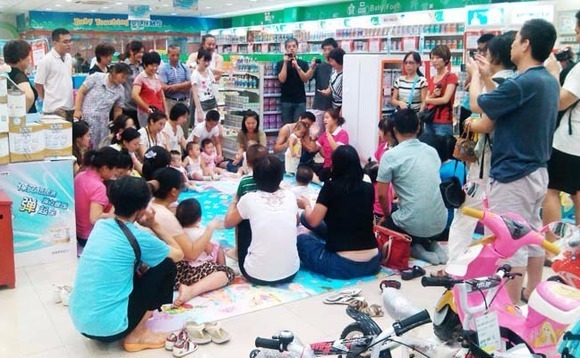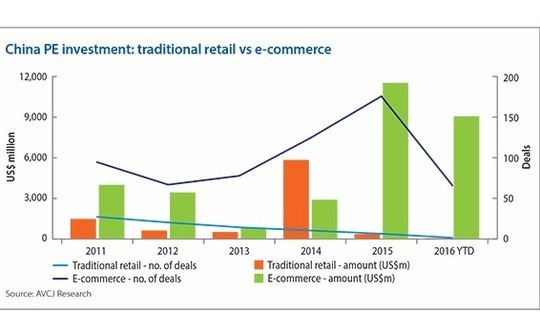
China O2O retail: It's good to touch

The rise of e-commerce in China has placed traditional retailers under pressure, but private equity investors are still finding opportunities with concepts that integrate online and offline
Founded two years before Alibaba Group came into existence, China-based maternity and baby products retailer Aiyingshi began as a catalog business: the CEO printed out product information, distributed it to the homes and offices of potential customers, and took their orders.
After few years, people started asking to see products before purchase. Aiyingshi duly opened its first store in Shanghai in 2005, enabling customers to get an idea of how items such as beds, toys and baby strollers might fit into their homes. This evolved into a network of 159 outlets across Shanghai, Zhejiang, Fujian and Jiangsu, augmented by an online presence.
Partners Group - which bought a minority stake in Aiyingshi from China New Enterprise Investment and other shareholders late last year - was encouraged by the retailer's two-prolonged approach. In the maternity, baby and child (MBC) space, products quality and safety are key concerns for families in first-tier cities. Parents would happily pay a 5-10% premium to shop offline rather than purely online if they trust the products and vendor.
In this respect, the impact of e-commerce on traditional retailers has not been uniform. While the low- to mid-range space has been thoroughly disrupted, high-end specialists like Aiyingshi continue to thrive. In a dynamic and fast-changing environment, GPs must think carefully about where they invest, and consider how the online-offline balance is likely to evolve.
"Today, having a presence online and offline is a must. Many online retailers are trying to open offline stores, because experiences offered to customers are so different from online. The O2O [online-to-offline] concept has been very popular in China over the last two years, and we realize that it's the future," says Sheng Liu, a senior vice president at Partners Group, who led Aiyingshi transaction. "Both models will be still there, but it won't be like before when you needed to open more physical stores to reach consumers."
Exception to the rule
China remains the world's largest e-commerce market, generating nearly RMB4 trillion ($700 billion) in revenue last year. The online share of overall retail continued to rise, reaching 43% in 2015 compared to 25% in 2012, according to a Bain & Company. From consumer electronics to women's shoes, new e-commerce players are proliferating thanks to lower price propositions.
PE investment in traditional retail peaked in 2014 at $5.87 billion, AVCJ Research's records show. From there the fall was dramatic, with investment plummeting to $336 million last year and just $30 million - in one transaction - so far this year. In contrast, commitments to e-commerce operators came to $2.9 billion in 2014 to $11.6 billion last year. For the first nine months of 2016, the total stands at $9 billion.
However, MBC is the exception to the rule. Following Warburg Pincus' investment in Kidswant in 2012, the deals have continued to flow. Lunar Capital, for example, has acquired several babywear brands over the last few years with a view to consolidating a segment that remains highly fragmented online and offline. The largest kidswear retailer in China, Balabala, only accounts for a 4% market share.
"The market itself is big enough, supported by younger couples who have a higher consumption demand for their kids, whether it is food, education or clothes," says Ke Chen, a partner at consulting firm Roland Berger. "For the older generation, parents might have bought one pair of sport shoes for their children. Now, though, kids have a different pair of shoes for each activity, whether it's football, running, tennis, basketball or general leisure."
In the face of intense competition from online players, offline retailers have little choice but to target similar price points. Aiyingshi has taken reference from its self-run online platform, picking bestselling products to showcase in offline stores. The company also offers discounts in a consistent manner so as to differentiate itself from online rivals that tend to select a few products for promotion each month, which may confuse shoppers.
This is in keeping with the key function of physical stores, which is to cultivate trust within the consumer base. JNBY, a mid-tier designer apparel brand backed by Vision Knight Capital, has 1,255 stores that build brand awareness first and serve as a sales point second. Retail efforts are driven by an omni-channel distribution strategy comprising various self-operated and third-party online platforms, including Alibaba's Tmall, JD.com, VIP.com and WeChat. The company filed for a Hong Kong IPO in June.

David Wei, co-founder and CEO of Vision Knight, says JNBY has cultivated demand through its offline presence by stocking high-end fabrics that customers can touch in order to distinguish from mass-market offerings.
"When we look at offline retail, one criteria is the products require detailed onsite customer experience that internet players cannot match. But these retailers should also build online shopping channels. It's just like Apple. While a lot of investment has gone into its flagship stores, these are for consumer experience as well as sales. Apple is an internet company and its sales are driven online," he adds.
There are various initiatives private equity investors can introduce to support these efforts. For example, Vision Knight has helped JNBY make its membership program fully O2O, pushing offline members to purchase clothes online in the last three years. This integration promotes cross-selling within the omni-channel and facilitates better inventory management.
However, Shaun Rein, managing director of China Market Research Group, notes that there are few PE investors with a deep enough understanding of online and offline to help traditional retailers transform themselves. Furthermore, investing in a mid-tier offline apparel brand in the hope of scaling up through various distribution channels is challenging due to a lack of strong home-grown brands. Indeed, China's growing legion of middle class travelers likes to shop for branded products overseas.
Richard Chen, a partner at Ceyuan Ventures, echoes this view. He led an investment in cross-border luxury fashion e-commerce platform Farfetch - which has 400 designer boutiques and global brands selling products to Asian customers - due to its scalability and flexibility.
"Today's young people are very fickle, they have many choices and different tastes. It is therefore difficult for retailers to create brands as big as Michael Kors or Ralph Lauren. These brands were created before the mobile and social media era. Nowadays, young people keep changing their styles, so it is hard to build a mega brand that everybody loves," says Chen.
Integrated approach
However, increased brand awareness has propelled the development of outlet malls in China. This concept - characterized by multiple brands and lower-than-main-street prices - has a long history overseas, but is only just taking root in China. While in the West outlets emerged as a channel for brands to clear inventory, Chinese shoppers see them as a mainstream retail channel and a first point-of-contact with brands.
Sasseur Group, a Chinese outlet mall developer that received backing from L Capital Asia in 2014, recently opened its six mall in Kunming, Yunnan province. The company aims to open three malls a year, targeting a portfolio of at least 20 by 2020. Revenue is growing 30% year-on-year and is expected to reach RMB22 billion during this period.
"The e-commerce boom has pushed traditional retailers to upgrade their offering, providing better services and experiences to consumers," says Vito Xu, Sasseur's founder and chairman. "We aim to create a unique shopping environment with attractive architecture and decoration. E-commerce cannot replace offline retail, but we do see them converging. We also have an O2O strategy in order to draw more traffic to the malls from online."
Nanjing Sasseur Art Commercial Plaza covers 200,000 square meters and is home to 600 fashion brands, as well as boasting 10,000 car-parking spaces. In addition to functioning as a traditional outlet - selling discounted products - it also features the kind of entertainment activities found in shopping malls. L Capital sees Sassuer as a business that can withstand, and even thrive, in the face of economic headwinds and e-commerce disruption.
Outlets represent one way in which brands can achieve awareness and on-the-ground coverage in China without spending heavily on self-owned stores. However, as Vision Knight's Wei and Sasseur's Xu suggest, these strategies cannot exist without a complementary online concept. Integration is the name of the game.
"The majority of the brands are trying to sell their products in multiple channels so as to maximize revenue. But retailers should ask themselves which channels deliver the best experience and which are most efficient, in addition to offering the best price for consumers. If they can answer those questions, they can grow," says Partners Group's Liu. "Otherwise, they will face a lot of challenges."
Latest News
Asian GPs slow implementation of ESG policies - survey
Asia-based private equity firms are assigning more dedicated resources to environment, social, and governance (ESG) programmes, but policy changes have slowed in the past 12 months, in part due to concerns raised internally and by LPs, according to a...
Singapore fintech start-up LXA gets $10m seed round
New Enterprise Associates (NEA) has led a USD 10m seed round for Singapore’s LXA, a financial technology start-up launched by a former Asia senior executive at The Blackstone Group.
India's InCred announces $60m round, claims unicorn status
Indian non-bank lender InCred Financial Services said it has received INR 5bn (USD 60m) at a valuation of at least USD 1bn from unnamed investors including “a global private equity fund.”
Insight leads $50m round for Australia's Roller
Insight Partners has led a USD 50m round for Australia’s Roller, a venue management software provider specializing in family fun parks.








